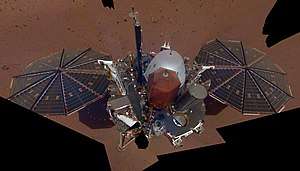2018 LA
2018 LA, also known as ZLAF9B2, was a small Apollo near-Earth asteroid 2.6–3.8 m (9–12 ft) in mean diameter that impacted the atmosphere with small fragments reaching the Earth at roughly 16:44 UTC (18:44 local time) on 2 June 2018 near the border of Botswana and South Africa. It was discovered only 8 hours prior by the Mount Lemmon Survey, Arizona and based on 1 1⁄2 hrs of observations, was calculated to have a roughly 85% chance of impact[6] likely somewhere between Australia and Madagascar.[7] Hours later, a report arrived to the American Meteor Society that an observer from Botswana had seen a bright fireball. After the impact, the Asteroid Terrestrial-impact Last Alert System (ATLAS) released observations roughly 2 hours after the other reported observations which confirmed that the asteroid had indeed impacted Earth on a grazing path as per the observed fireball. A preliminary analysis of the pre-impact evolution of this meteoroid suggests that it may be part of a dynamical grouping.[8][9][10]
 Orbit and positions of 2018 LA, 30 days before collision | |
| Discovery [1][2] | |
|---|---|
| Discovered by | Mount Lemmon Srvy. Richard Kowalski [3] |
| Discovery site | Mount Lemmon Obs. |
| Discovery date | 2 June 2018 |
| Designations | |
| 2018 LA | |
| ZLAF9B2 (NEOCP) | |
| NEO · Apollo [1][4] | |
| Orbital characteristics [4][5] | |
| Epoch 2 June 2018 (JD 2458271.5) | |
| Uncertainty parameter 8[4] · 6[1] | |
| Observation arc | 3.8 hours (14 obs.) |
| Aphelion | 1.9709 AU |
| Perihelion | 0.7820 AU |
| 1.3764 AU | |
| Eccentricity | 0.4319 |
| 1.61 yr (590 d) | |
| 326.73° | |
| 0° 36m 37.08s / day | |
| Inclination | 4.2975° |
| 71.870° | |
| 256.05° | |
| Earth MOID | < 5000 km |
| Venus MOID | 0.0557 AU |
| Mars MOID | 0.0191 AU |
| Physical characteristics | |
Mean diameter | 1.6–5.2 m (5.2–17.1 ft) (est. 0.05–0.3) 2.6–3.8 m (8.5–12.5 ft) (est. impact energy) |
| Mass | 25–35 t (55,000–77,000 lbs.) |
| 0.15–0.30 (est. impact size) | |
| 18.3 (at discovery) | |
| 30.554[4] 30.6[1] | |
Discovery
On 2 June 2018, at roughly 08:22 UTC (01:22 local time), the Mount Lemmon Survey picked up an 18th magnitude asteroid moving quickly against the background stars. The object was observed over the course of 15 minutes and submitted to the Minor Planet Center, and was followed up by the same survey for the next hour or so, resulting in an Observation arc of 1 hour and 17 minutes. The asteroid was soon identified as having a chance of impacting Earth (identified by JPL's scout program as 30% odds, calculated by Bill Gray as 82%) and one precovery observation was found just 7 minutes prior to its discovery observation, resulting in a final observation arc of 85 minutes before the asteroid was widely considered lost.
Entry and ATLAS observations

Several hours later, at 16:44 UTC, a report arrived from southern Botswana to the American Meteor Society that an exceptionally bright fireball had been spotted. Although this was further west than projected based on the initial observations, the timing and location were consistent, although substantiated by just one observer.
Confirmation that the asteroid had impacted Earth, rather than simply a near approach, came when two observations by the Asteroid Terrestrial-impact Last Alert System (ATLAS) arrived later the same day and extended the observation arc from 85 minutes to 3 hours and 47 minutes, significantly improving the orbital parameters.[1] The 4 hour observation arc better constrained the line of variations and showed that the asteroid was virtually certain to impact Earth, and based only on the sky observations, projected to have impacted in Namibia instead. This proves consistent with the fireball report.
The bolide was also detected by infrasound at station I47 in South Africa and registered about 0.4 kt.[11] The asteroid was several meters in diameter and impacted the atmosphere going about 17 km/s (38,000 mph). Based on its velocity and energy, the asteroid was likely 2.6-3.8 meters in diameter.
Asteroids in the range of several meters in diameter are very hard to detect as they are too small to reflect much sunlight. For example, on 24 May 2018, the asteroid was still 0.069 AU (10,300,000 km; 6,400,000 mi) from Earth and only had an apparent magnitude of 25.5, much dimmer than any major modern surveys can detect using rapid-fire 30 second snapshots meant to cover as much of the sky as possible.[12]
Fragment recovery
Scientists promptly looked for a meteorite strewn field, hoping to recover fragments of the asteroid before they had a chance to weather too much. Fragments can achieve dark flight after deceleration to terminal velocity. Dark flight starts when fragments decelerate to about 2–4 km/s. Larger fragments will fall further down the strewn field.
Assuming a similar fraction of 2018 LA survived as of 2008 TC3, several kilograms in total were expected to have reached the ground and be recoverable, if estimates of 40% as massive as 2008 TC3 were correct. On June 23 the first meteorite fragments were recovered by scientists, the physical characteristics of which may have been published.[13]
See also
- Chelyabinsk meteor
- Impact event
- List of asteroid close approaches to Earth in 2018
- 1930 Curuçá River event
- Sikhote-Alin meteorite
- Tunguska event
- Asteroid impact prediction
- 2008 TC3, the first asteroid ever discovered prior to impact
- 2014 AA, the second asteroid discovered prior to impact
- Vela Incident
- WT1190F, space debris that re-entered in 2015
References
- "2018 LA". Minor Planet Center. Retrieved 14 June 2018.
- "MPEC 2018-L04 : 2018 LA". Minor Planet Center. 3 June 2018. Retrieved 3 June 2018. (K18L00)
- "Tiny Asteroid Discovered Saturday Disintegrates Hours Later Over Southern Africa". NASA/JPL. Jet Propulsion Laboratory. Retrieved 4 June 2018.
- "JPL Small-Body Database Browser: (2018 LA)" (2018-06-02 last obs.). Jet Propulsion Laboratory. Retrieved 14 June 2018.
- Gray, Bill. "Pseudo-MPEC for ZLAF9B2". Project Pluto. Archived from the original on 2 June 2018. Retrieved 3 June 2018.
- Gray, Bill. "Re: {MPML} Re: [neo_followup] Further on ZLAF9B2". MPML. Retrieved 3 June 2018.
- https://www.projectpluto.com/temp/z.png
- de la Fuente Marcos, Carlos; de la Fuente Marcos, Raúl (18 June 2018). "On the Pre-impact Orbital Evolution of 2018 LA, Parent Body of the Bright Fireball Observed Over Botswana on 2018 June 2". Research Notes of the AAS. 2 (2): 57. arXiv:1806.05164. Bibcode:2018RNAAS...2b..57D. doi:10.3847/2515-5172/aacc71.
- de la Fuente Marcos, Carlos; de la Fuente Marcos, Raúl (26 July 2018). "Pre-airburst Orbital Evolution of Earth's Impactor 2018 LA: An Update". Research Notes of the AAS. 2 (3): 131. arXiv:1807.08322. Bibcode:2018RNAAS...2c.131D. doi:10.3847/2515-5172/aad551.
- de la Fuente Marcos, C.; de la Fuente Marcos, R. (2019). "Waiting to make an impact: A probable excess of near-Earth asteroids in 2018 LA-like orbits". Astronomy and Astrophysics. 621: A137 (7 pp.). arXiv:1811.11845. Bibcode:2019A&A...621A.137D. doi:10.1051/0004-6361/201834313.
- Brown, Peter. "Strong infrasound detection of a bolide at station I47 in South Africa". Retrieved 3 June 2018.
- Stolte, Daniel. "What it Takes to Discover Small Rocks in Space". University of Arizona News. Retrieved 8 June 2018.
- First Fragment Of Shattered Asteroid Recovered In Botswana July 6, 2018, Bob King
External links
- Tiny Asteroid Discovered Saturday Disintegrates Hours Later Over Southern Africa JPL, June 3, 2018
- Small Asteroid 2018 LA impacted Earth on 02 June – Ernesto Guido
- An Asteroid was Discovered Just Hours Before it Exploded over Africa Fraser Cain, 6/5/18
- Tiny Asteroid 2018 LA Hits Earth Hours After Discovery 6/5/18 Bob King
- What it Takes to Discover Small Rocks in Space 6/6/18 Daniel Stolte
- Sormano Astronomical Observatory: APEC interesting Asteroids Past Earth Close encounters
- 2018 LA at NeoDyS-2, Near Earth Objects—Dynamic Site
- Ephemeris · Obs prediction · Orbital info · MOID · Proper elements · Obs info · Close · Physical info · NEOCC
- 2018 LA at the JPL Small-Body Database


